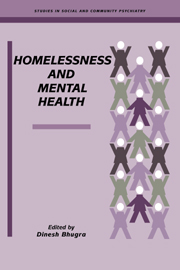Book contents
- Frontmatter
- Contents
- List of contributors
- Preface
- Part I INTRODCTION AND SPECIAL GROUPS
- Part II SERVICES
- 7 Services for the mentally ill homeless
- 8 Clinical work with homeless people in the USA
- 9 The severely mentally ill in hostels for the homeless
- 10 Old and homeless in London and New York City: a cross-national comparison
- 11 Primary health care of the single homeless
- Part III INTERNATIONAL PERSPECTIVE
- Part IV POLICY AND EVALUATION
- Index
7 - Services for the mentally ill homeless
from Part II - SERVICES
Published online by Cambridge University Press: 15 October 2009
- Frontmatter
- Contents
- List of contributors
- Preface
- Part I INTRODCTION AND SPECIAL GROUPS
- Part II SERVICES
- 7 Services for the mentally ill homeless
- 8 Clinical work with homeless people in the USA
- 9 The severely mentally ill in hostels for the homeless
- 10 Old and homeless in London and New York City: a cross-national comparison
- 11 Primary health care of the single homeless
- Part III INTERNATIONAL PERSPECTIVE
- Part IV POLICY AND EVALUATION
- Index
Summary
Introduction
As for estimates of homeless populations in various countries (see Chapters 10, 12, 13 and 14) the estimates of various types of mental illness and other psychological morbidity in homeless populations vary. Most of the research so far has been in the ‘captive’ samples that are easy to approach and identify and findings from these populations cannot be generalized. We know from the existing literature that most homeless individuals do not receive help from any service agency and their distrust of statutory health services and the inflexibility of these services in return are important factors in continuing poor physical and mental conditions.
Between one third and one quarter of the homeless population suffers from serious mental illness (Tessler & Dennis, 1989; Dennis et al., 1991; see Bhugra 1993, for a review). The relationship between homelessness and mental illness is complex and mental illness is only one of many interacting factors leading to and perpetuating homelessness. In addition, other factors include the reduction in availability of low cost housing, increasing unemployment, loss of the manufacturing base (in the UK) and closure of direct access hostels, which traditionally served as asylums for large numbers of the mentally ill (Craig & Timms, 1992; see Chapters 2 and 3). Cohen & Thompson (1992) argue that the distinction between the homeless mentally ill and the mentally ill homeless is not a semantic one but is vital in terms of addressing needs and in the development of services.
- Type
- Chapter
- Information
- Homelessness and Mental Health , pp. 99 - 109Publisher: Cambridge University PressPrint publication year: 1996
- 6
- Cited by



